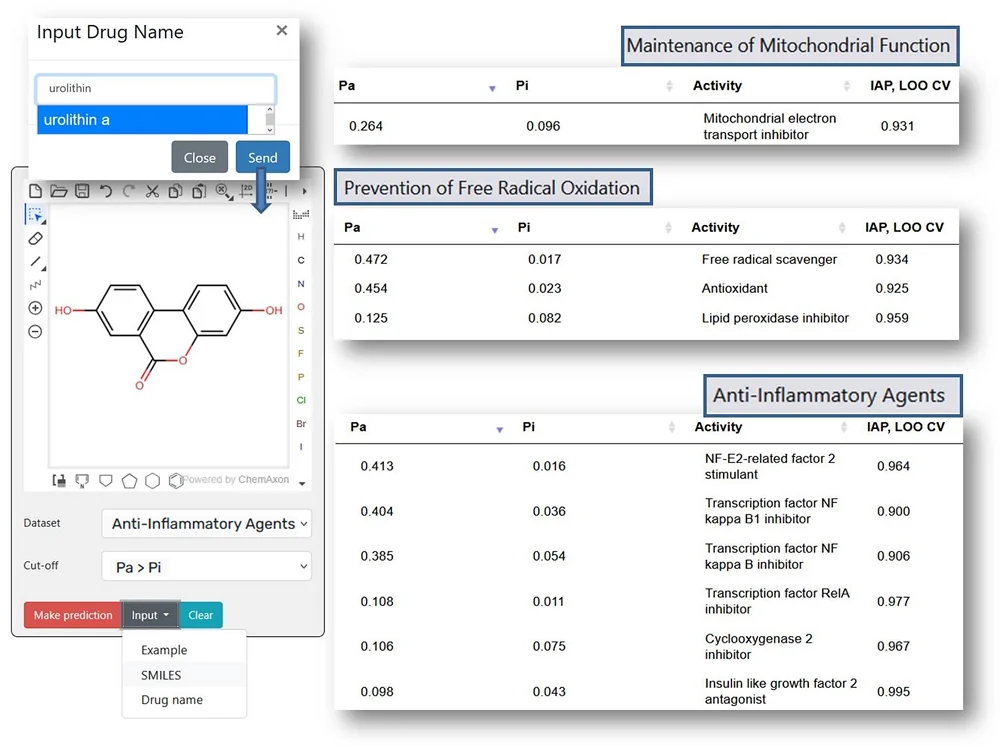Researchers publishing in the International Journal of Molecular Sciences have showcased their creation of PASS GERO, a public-facing application that allows researchers to evaluate potential anti-aging compounds.
Taking a PASS at aging
This paper begins with a discussion of how aging is currently treated, with a focus on lifespan and chronic conditions. The researchers echo the common refrain that such conditions, including cancer and neurological problems are only treated after they have already occurred, with little attention paid to potential methods of preventing them. Such compounds, known as geroprotectors, have proven to be difficult to test in humans, and so bringing them into the clinic is challenging [1].
In order to make the earliest stages of drug development easier, these researchers have developed an application based on Prediction of Activity Spectra for Substances (PASS) software, which estimates a potential drug’s predicted biological activity based on its structure [2]. Currently, PASS encompasses over 9,000 biological activity types with a training set of nearly 1.5 million compounds. PASS has already been used in the development of potential drugs for the treatment of age-related diseases [3].
PASS GERO is a specialized version of PASS, with an additional 117 mechanisms related to anti-aging activities. These mechanisms directly address hallmarks such as mitochondrial dysfunction, cellular senescence, and epigenetic alterations. Its creators found PASS GERO to be even more accurate than the already highly accurate PASS, and they further found that it correctly identifies the mechanisms of action of well-known and commonly taken drugs such as metformin.
A wide variety of targets
The particular categories that PASS GERO identifies include antioxidant activity, including compounds that scavenge free radicals along with those that chelate metals and inhibit certain avenues of oxidation. Specific mitochondrial functions are considered, and the software looks for compounds that enhance the cellular maintenance process of autophagy. Proteostasis is addressed, includiing compounds that inhibit the production of amyloid protein aggregates.
Telomerase stimulants, compounds with anti-mutagenic effects, and various regulators of specific epigenetic effects are included. As expected, the mTOR and AMPK pathways are also targeted, as is the NF-κB inflammatory pathway and MMP-9, which is associated with inflammation and fibrosis. Fibrosis is also its own target in PASS GERO.
The software also looks for compounds that may support neurons, including potential memory drugs, along with compounds that benefit the thymus, the organ that trains T cells. Finally, the software targets multiple miscellaneous age-related alterations, including some that are related to diabetes.
Free to the public
Unlike many other databases in this industry, these researchers have chosen to make their tool free and available to the public. The website encourages visitors to import SMILES molecular data or use a site-based tool to create compounds or modify existing ones. The site assesses the probability of any compound’s potential activity, and it offers thresholds such as its probability being over a certain percentage or simply being above its probability of inactivity.

While this is a potentially useful tool, all in silico compound analysis does come with some caveats. There is, of course, always the potential for toxicity and off-target effects, compounds created within a web-based tool may be impossible to create in practice, and such a database cannot determine if any particular drug works in some populations but not others. However, researchers seeking to determine if any given substance may or may not be viable as a treatment for a specific age-related disease can first experiment with this tool, potentially finding promising candidates or discarding unpromising ones before serious effort is expended or the first animal is dosed.
Literature
[1] Moskalev, A. A. (2023). Potential geroprotectors–from bench to clinic. Biochemistry (Moscow), 88(11), 1732-1738.
[2] Mervin, L. H., Afzal, A. M., Drakakis, G., Lewis, R., Engkvist, O., & Bender, A. (2015). Target prediction utilising negative bioactivity data covering large chemical space. Journal of cheminformatics, 7(1), 51.
[3] Corominas-Faja, B., Santangelo, E., Cuyàs, E., Micol, V., Joven, J., Ariza, X., … & Menendez, J. A. (2014). Computer-aided discovery of biological activity spectra for anti-aging and anti-cancer olive oil oleuropeins. Aging (Albany NY), 6(9), 731.



